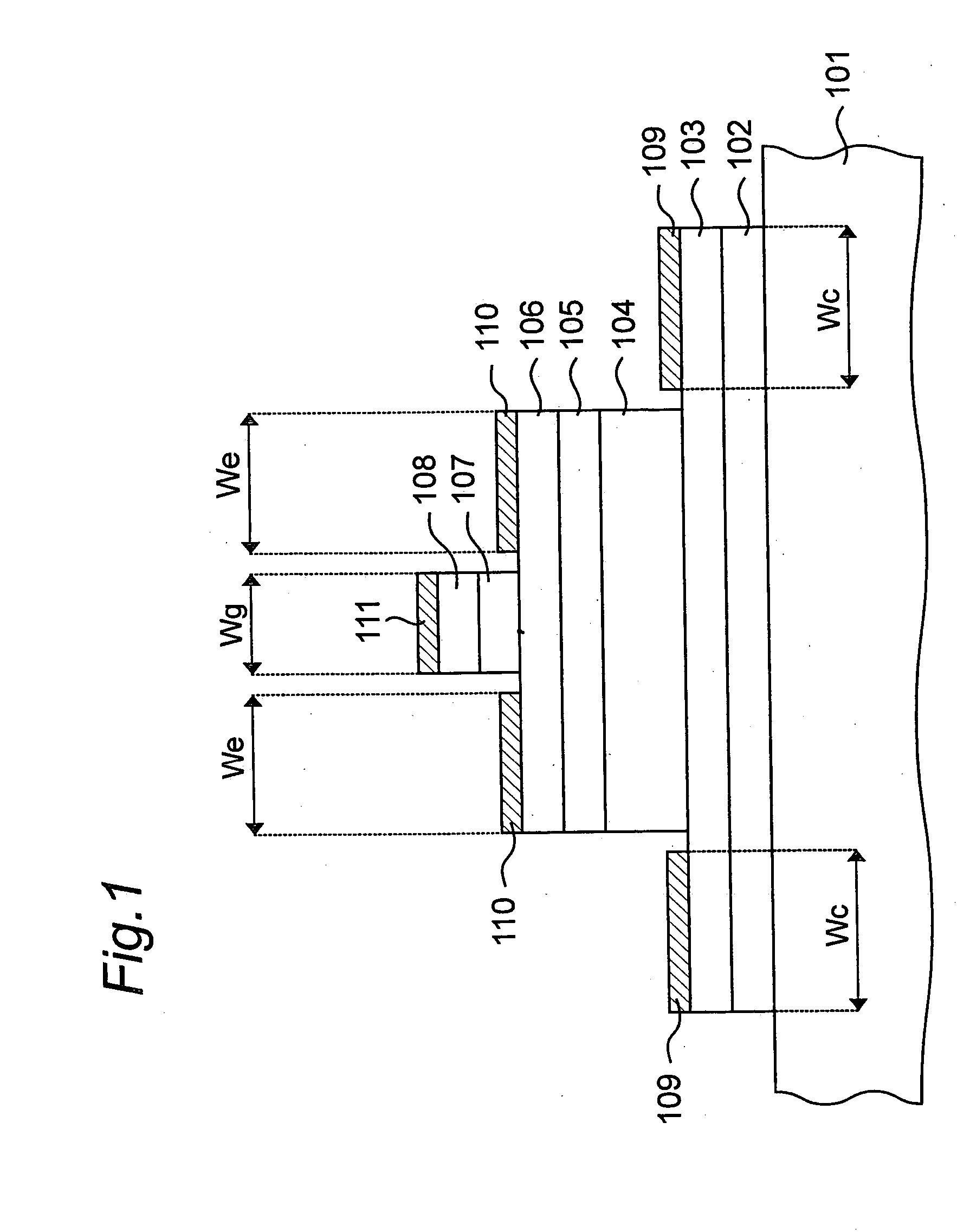Bipolar transistor
a transistor and bipolar technology, applied in the field of bipolar transistors, can solve the problems of low activation rate of mg, low hole mobility, and high base resistance rsub>b /sub>, and achieve the effect of high current gain
- Summary
- Abstract
- Description
- Claims
- Application Information
AI Technical Summary
Benefits of technology
Problems solved by technology
Method used
Image
Examples
first embodiment
The First Embodiment
[0085]FIG. 7 shows the cross-sectional structure of the device of the first embodiment to which this invention is applied.
[0086] This device is provided with an n-GaN subcollector layer (layer thickness: 100 nm, Nd=5×1018 cm−3) 703, an n-InxGa1-xN collector layer (layer thickness: 500 nm, In composition ratio x=0→0.2, Nd=1×1016 cm−3) 704 formed in a central region of the upper surface of this subcollector layer 703, a p-In0.2Ga0.8N base layer (layer thickness: 25 nm, Na=5×1019 cm3) 705 that serves as a second conductive type carrier retaining layer, an n-GaN emitter layer (layer thickness: 80 nm, Nd=5×1018 cm−3) 706 and a p-Al0.2Ga0.8N gate layer (layer thickness: 50 nm, Na=5×1018 cm−3) 707 formed in a central region of the upper surface of this emitter layers 706. The In crystal mixture ratio x of the n-InxGa1-xN collector layer 704 is graded so that x=0 on the subcollector layer side and x=0.2 on the base layer side. The collector layer 704 is also called the ...
second embodiment
The Second Embodiment
[0097]FIG. 10 shows the cross-sectional structure of the device of the second embodiment to which this invention is applied.
[0098] This device is provided with an n-GaN subcollector layer (layer thickness: 100 nm, Nd=5×1018 cm−3) 1003, an n-InxGa1-xN collector layer (layer thickness: 500 nm, In composition ratio x=0→0.2, Nd=1×1016 cm−3) 1004 formed in a central region of the upper surface of this subcollector layer 1003, an n-GaN emitter layer (layer thickness: 80 nm, Nd=5×1018 cm−3) 1006 and a p-Al0.2Ga0.8N gate layer (layer thickness: 50 nm, Na=5×1011 cm−3) 1007 formed in a central region of the upper surface of this emitter layer 1006. The In crystal mixture ratio x of the n-InxGa1-xN collector layer 1004 is graded so that x=0 on the subcollector layer side and x=0.2 on the emitter layer side.
[0099] A collector electrode 1009, an emitter electrode 1010 and a gate electrode 1011 are formed similarly to those of the first embodiment. The collector electrode 1...
third embodiment
The Third Embodiment
[0108]FIG. 12 shows the cross-sectional structure of the device of the third embodiment to which this invention is applied.
[0109] This device is provided with an n-GaN subcollector layer (layer thickness: 100 nm, Nd=5×1018 cm−3) 1203, an n-InxGa1-xN collector layer (layer thickness: 500 nm, In composition ratio x=0→0.2, Nd=1×1016 cm−3) 1204 formed in a central region of the upper surface of this subcollector layer 1203, an n-GaN emitter layer (layer thickness: 80 nm, Nd=5×1018 cm3) 1206 and an AlxGa1-xN gate layer (layer thickness: 25 nm, Al composition ratio x=0.1→0.3, undoped) 1207 formed in a central region of the upper surface of this emitter layer 1206. The In crystal mixture ratio x of the n-InxGa1-xN collector layer 1204 is graded so that x=0 on the subcollector layer side and x=0.2 on the emitter layer side. Moreover, the Al crystal mixture ratio x of the AlxGa1—N gate layer 1207 is graded so that x=0.1 on the emitter layer side and x=0.3 on the upper su...
PUM
 Login to View More
Login to View More Abstract
Description
Claims
Application Information
 Login to View More
Login to View More - R&D
- Intellectual Property
- Life Sciences
- Materials
- Tech Scout
- Unparalleled Data Quality
- Higher Quality Content
- 60% Fewer Hallucinations
Browse by: Latest US Patents, China's latest patents, Technical Efficacy Thesaurus, Application Domain, Technology Topic, Popular Technical Reports.
© 2025 PatSnap. All rights reserved.Legal|Privacy policy|Modern Slavery Act Transparency Statement|Sitemap|About US| Contact US: help@patsnap.com



